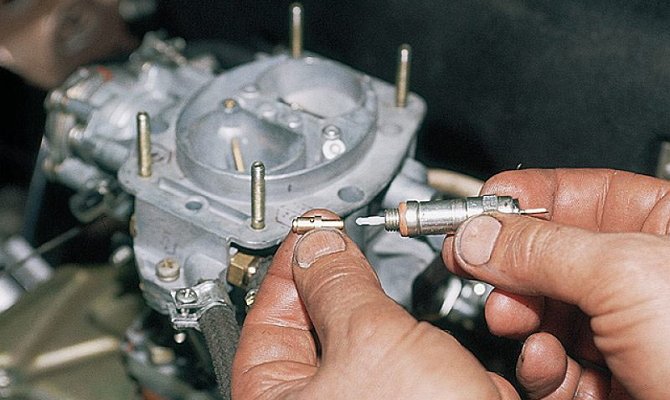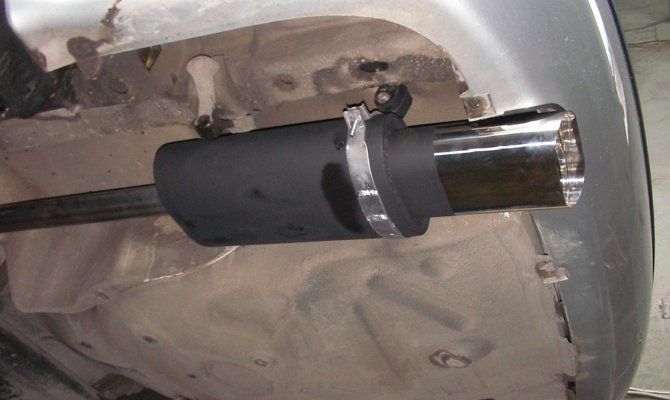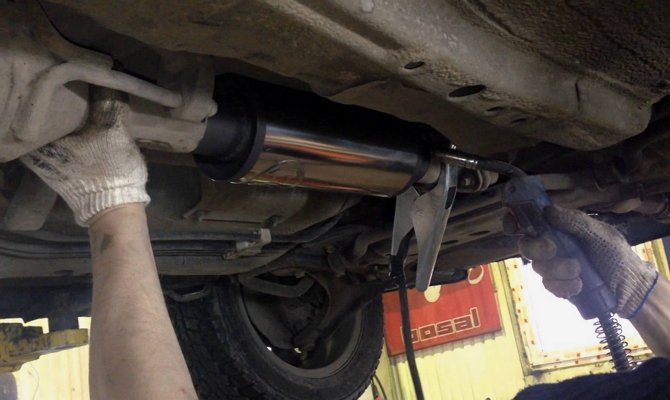
Exhaust gas temperature sensor - how does it relate to cabin odors?
Content
The exhaust gas temperature sensor very rarely receives the attention of car owners, and in vain. Consider its functions, dwell on the causes of unpleasant odors in the cabin and discuss the converter and the recirculation system.
Content
- 1 Carburetor and everything, everything, everything ... - whose exhausts?
- 2 Where are the reasons?
- 3 Composition and emission standards
- 4 Diagnosis with your own eyes
- 5 What can be done?
- 6 How to reduce the concentration of exhaust?
Carburetor and everything, everything, everything ... - whose exhausts?
The car consists of several systems (cooling, recirculation, fuel supply, etc.), a carburetor located in the crankshaft crankcase, many valves ... You can’t list all the elements. The cylinder block and crankshaft of the engine are located in the crankcase, and the carburetor is responsible for obtaining the combustible mixture of the required concentration. He also regulates its supply to the cylinders, where combustion occurs. At the same time, a mandatory operation for air and gasoline before they enter the carburetor is cleaning.

car carburetor
The movement of the engine piston starts from top dead center, and a combustible mixture is sucked into the cylinder. The valve is in the open position. Next, the mixture is compressed in the cylinders. The piston moves to the lowest position, the valves are closed as tightly as possible. This is followed by a work cycle during which a mini-explosion occurs. The fuel mixture from the carburetor, compressed by the piston, is ignited in the crankcase by a spark from a spark plug. And the last step is the release of spent substances.
Since the operation of the engine involves high temperatures, a special cooling system is required. This will extend the life of the parts. Another function of the cooling system is to regulate the temperature of the exhaust. The carburetor is a rather complex device, so there can be quite a lot of malfunctions in it.
Where are the reasons?
If an unpleasant smell of unknown origin has appeared in the cabin, then it is impossible to tighten it. Often the smell of exhaust gases in the cabin causes leaks in the system, and breakdowns should be looked for in the engine compartment. It can be a stove or the combustion residue removal system itself. In station wagons and hatchbacks, this smell often penetrates through the luggage compartment. Opening the rear door or window, and any depressurization in this compartment (damaged seal) leads to air discharge, as a result, gas exhaust is drawn out.


Exhaust smell in the cabin
Sometimes the car smells like rotten eggs, this is the first sign that the catalyst has deteriorated.. This device fights harmful substances that make up the exhaust. The catalytic converter most often fails due to low-quality fuel. Still, of course, the device has a certain period of operation. Incorrect operation of the catalyst leads to a decrease in engine performance. A failed recirculation system, for example, a broken valve, will not have the best effect.
A sweet smell indicates a leak of antifreeze, which can be facilitated by violations in the cooling system. But if there is too much smoke coming out of the exhaust pipe, the carburetor is probably faulty. Again, a failed cooling system can provoke this.


Watch this video on YouTube
Composition and emission standards
Before we touch on the exhaust gas removal system, a little attention should be paid to the properties and composition of emissions. An increased concentration of harmful exhausts is most likely at high speeds. This is facilitated by a combination of strong vacuum with high speeds. And as you know, the consequences of carbon monoxide poisoning can be very different depending on their concentration.


Consequences of carbon monoxide poisoning
Now let's talk about the composition of the exhaust, and what rate is considered acceptable. These emissions contain toxic substances - aldehydes, hydrogen oxides, carbon monoxide. They also contain carcinogens. These include soot and benzpyrene. All this weakens the immune system, and exhaust can also cause bronchitis, sinusitis, respiratory failure, laryngotracheitis and even lung cancer. They can cause disorders of the cardiovascular system and provoke atherosclerosis of the brain.
According to EU standards, the permissible norm is CO 0,5-1 g/km, HC - 0,1 g/km, NOx from 0,06 to 0,08 and PM 0,005 g/km. The numbers used to be higher. But since today the fuel has become of better quality, there are special recirculation systems and a converter, this rate has decreased significantly.


Watch this video on YouTube
Diagnosis with your own eyes
Let's start with the internal space, because very often it is the exhaust system that can cause such a nuisance. We open the hood and study the state of the connection between the cylinder head and the exhaust manifold. It does not interfere with making sure the integrity of the gasket. Sometimes it smells of gases inside the car and due to a loose fit of the collector as a result of loose fasteners.
Now we need a viewing hole, otherwise it will not work to study the bottom. We turn on the engine and carefully check all the elements for leakage. We evaluate each muffler and distribution tank in turn. If everything is in order with these elements, then you can go to the pipes. Gently run your hand over them. Do not ignore the rocker boot either, it is likely that it was its leak that caused the problem.


Checking the muffler for a leak
The cause has not been found, and the exhaust system has nothing to do with it? Then gradually move on to the luggage compartment. The weakest point here is the door seal, over time it loses its elastic properties, cracks, which is quite enough for depressurization. In order to identify where the elastic does not fit snugly enough, it is necessary to glue it with white masking tape and then paint, for example, the strip located on top with shoe polish in a uniform layer. We close the trunk and open it. Now we look at the bottom tape, in places where there is no paint, the seals do not touch reliably enough.
Next, we turn to ventilation, of course, if any. Be sure to visually check its check valves. It makes sense to check the surface for the presence of through rust. But at this stage you will have to work hard, because in order to get to the metal, you should dismantle the plastic pocket. Check the rear light seals. It is possible that they are damaged or lost.
If the cause is still not identified, then you should pay attention to the air filter and rear window seals. They also deteriorate over time and allow air to pass through from the outside. Do you suspect that the cooling system is to blame? Then study it too. Look at all the tubes, they may be leaking. Even a minor leak in the cooling system increases over time, which will lead to more serious consequences. Or maybe the problem lies in the carburetor?


Watch this video on YouTube
What can be done?
If the exhaust system is leaking, the problem must be repaired immediately. A failed catalytic converter needs to be replaced. Sometimes it is worth changing the seals. Perhaps the whole thing is in the valve of the recirculation system, then the entire device needs to be replaced. Faulty cooling system radiator? Contact a car service, this problem should be solved by specialists. This also applies to the carburetor. If you have fixed the malfunctions, but it still smells of exhaust, then we are looking for rotten areas. This also occurs.


Replacing a failed catalytic converter
If you find an exhaust gas analyzer, then there is a chance to measure their toxicity as accurately as possible. But regardless of this indicator, additional air purification from harmful impurities is very important not only in the passenger compartment, but also in a working room, for example, a workshop, since no recirculation system can reduce their toxicity to an acceptable limit. A powerful hood can provide a similar effect.
These devices are divided into guard, drum and most popular in service stations - channel systems. The advantage of the first option is low cost. They are divided depending on the mounting on the wall and ceiling. The drum-type hood is mainly located on the ceiling. Especially convenient is the device with an electric drive. But air purification using a channel system is more efficient and economical.


Watch this video on YouTube
How to reduce the concentration of exhaust?
We have learned the principle of operation of an internal combustion engine, the role of cooling in this process, what exhaust gas removal systems exist, now it's time to discuss the catalyst. The recirculation system consists of a valve, which, under certain conditions, combines the spaces of two manifolds - inlet and outlet. Part of the exhaust enters the cylinders, which leads to a decrease in the combustion temperature. As a result, the amount of nitrogen oxides in emissions is reduced. The valve of the simplest recirculation systems opens under the action of vacuum. During idling, this node ceases to function. In more complex recirculation systems, an electronic valve controlled by a computer is installed.


Watch this video on YouTube
The catalytic converter is assembled from a housing, carrier unit and thermal insulation. The base is a ceramic block of longitudinal honeycombs. On the surface of these cells, special catalysts are applied to speed up chemical reactions in the converter. These catalysts are divided into oxidizing (palladium and platinum) and reducing (radium). Thanks to their action, the composition of the exhaust is regulated. If the device uses all of the listed components, then such a neutralizer is called a three-component one.
The carrier block of the neutralizer is located in a metal case. Between these elements is a layer of thermal insulation. Another catalytic converter assumes the presence of an oxygen sensor. An exhaust gas temperature sensor is also installed in front of it. It transmits the appropriate signals to the ECU, by which the fuel injection is controlled, and the exact amount necessary for burning soot enters the system.